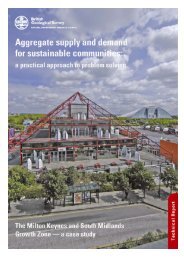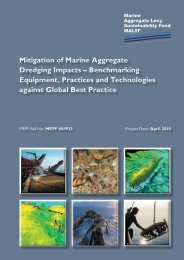creating environmental improvements through biodiversity
creating environmental improvements through biodiversity
creating environmental improvements through biodiversity
Create successful ePaper yourself
Turn your PDF publications into a flip-book with our unique Google optimized e-Paper software.
ut should not necessarily be applied to other types of quarry. The report also discusses hard rock quarries<br />
where natural colonisation is likely to be slow or unviable (e.g. due to harsh environment, lack of sources of<br />
colonisers), and habitat creation techniques where natural colonisation is not possible.<br />
Cripps et al. (2004) and White & Gilbert (2003) include tables of information sources (including NGOs,<br />
statutory conservation bodies, specialist local species groups), and types of information to gather (including<br />
habitats and species). These lists should be made widely available and kept up to date. Cripps et al. (2004)<br />
also discusses landfill sites, stating that ‘the consideration of nature conservation interests and the potential<br />
for wildlife enhancement <strong>through</strong> habitat creation at landfill sites is also the subject of guidance published by<br />
the Wildlife Trusts (Ecoscope 2000)’.<br />
Cripps et al. (2004) also gives pointers to guidance on vegetation establishment (seeding and planting) for<br />
habitat creation. It provides a summary of the main techniques for vegetation establishment, with a pointer<br />
to seek advice on the most appropriate methods for a particular site or scheme. It points to information on<br />
available vegetation establishment techniques and habitat design. The report also discusses the relationship<br />
of soil nutrients to habitat creation, and provides a table on soil fertility in some important habitats (this is<br />
also in the Habitat Creation handbook - White and Gilbert, 2003). In addition it contains tables of typical<br />
detailed site investigations, including vegetation/habitat surveys, faunal surveys, landscape and visual impact<br />
assessment and landscape character assessment; and it highlights the importance of carrying out on-site trials<br />
of establishing different vegetation types.<br />
Sustainable Aggregates Creating Environmental Improvements <strong>through</strong> Biodiversity<br />
Worcestershire County Council provides key information on creation of habitats at aggregate sites (with<br />
advice to seek skilled ecological guidance prior to <strong>creating</strong> them). Also discusses natural regeneration at<br />
minerals sites and local sourcing of seeds species for planting.<br />
Research into restoration techniques<br />
Hafren Water propose reviewing floating wetland restoration techniques, including ecological, hydrological<br />
and engineering issues. They are also assessing the ecological/ <strong>biodiversity</strong> value of floating wetlands. We await<br />
the results with interest.<br />
Allen (2004) contains a wealth of information that could provide useful advice and background for minerals<br />
planners and operators on restoration of silt lagoons, if disseminated widely. It should certainly act as a<br />
starting point for more research in this area. Reedbeds and woodland were amongst the most common<br />
end-uses of silt lagoons, and natural regeneration can be an effective tool here in many cases. However,<br />
some surprising habitats were also noted. The report explains that on-site management of silt lagoons<br />
will determine their final restoration, and notes that most planning applications had little detail on design,<br />
operation or restoration of silt lagoons (although in some cases details were a condition of planning<br />
permission or review).<br />
Site design<br />
Many site BAPs and restoration plans would benefit from being less ambitious in the numbers of habitats<br />
included, and more ambitious in terms of scale – i.e. incorporating larger areas of fewer habitat types.<br />
Hafren Water (2007) stresses the difference (and different value) between targeted habitat creation and<br />
the ‘parkland lake’ landscapes that often result from restorations; and highlights opportunities to create<br />
priority wildlife habitats. McColl-Grubb et al. (2004) states that there is a lack of clarity in the minerals<br />
19

















